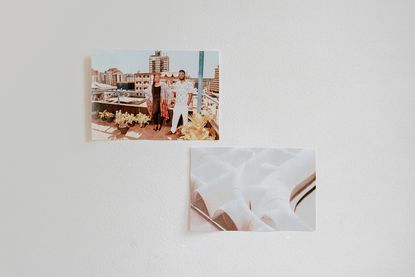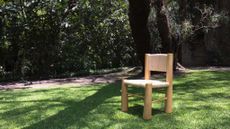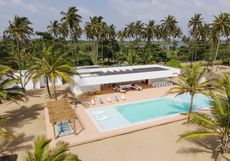Nigerian Studio Contra blends contemporary culture with local craftmanship
Nigerian Studio Contra is part of our series of profiles of architects, spatial designers and builders shaping West Africa's architectural future
- (opens in new tab)
- (opens in new tab)
- (opens in new tab)
- Sign up to our newsletter Newsletter

Olayinka Dosekun-Adjei and Jeffrey Adjei were motivated to establish the Nigerian Studio Contra, their joint practice, in 2016, inspired by a mutual desire to create innovative architecture for African cities. The married couple first met as employees at Sheppard Robson, one of the UK’s most established architecture firms. Dosekun-Adjei, who was raised in Nigeria, and Adjei, a Ghanaian, decided to set up their own studio in Lagos. Drawn to its energy and commercial dynamism, they saw the city as the perfect platform to effect social change and express cultural ideas through design.
Today, the 15-member architecture, interior and urban design practice – part of the Wallpaper* Architects’ Directory 2022 – is in the process of executing a spate of cultural commissions in Kwara, a state in the western region of Nigeria. These include the Ilorin Museum and Garden scheme – a modern update of the old and dilapidated Kwara Museum of Ilorin. The new 35,000 sq ft space will house classical Nigerian sculptures, while the derelict colonial building is to be redeveloped into a café and gift shop.

Studio Contra's Red Clay Villa design
West African studios: Studio Contra
Meanwhile, a 24,000 sq ft Institute of Contemporary African Art & Film in Kwara is in the works, with completion expected in early 2023. A third project in the region – Sugar Factory Film Studios – will see a decades-old disused sugar factory repurposed into film studios. This scheme exemplifies their approach to adaptive reuse – an attractive proposition for the architects considering its lower carbon approach to building.
‘We’re taking something that’s been undervalued, and we’re adding value to it. We're transforming it and offering it back to the city. I think it's a more sustainable approach,’ Dosekun-Adjei says.

An additional renovation project in Lagos – a city filled with underutilised building stock, according to the pair – involves the redesign of the 9,500 sq ft Centre of Contemporary Art from façade to interior.
The architects are particularly passionate about cultural projects due to the impact they leave on society and the cities they occupy. However, Adjei explains that these commissions, often government-funded, can be challenging to navigate for fledgling firms.
‘It's a very long, drawn-out process, so you can easily bankrupt your company if you want to stay within that sector alone. We find that we have to take on a variety of residential projects to keep us going and cover our overheads,’ Adjei explains.

Institute of Contemporary African Art & Film
Private houses, such as the Quartey Residence in Accra, are being constructed with locally produced half-fired clay bricks – a process less energy intensive than the use of commonly used concrete. Such projects have inspired the partners to hire an architect to specifically investigate domestic building materials and craftsmanship that can be incorporated into their schemes.
Although the architects say that they are yet to develop a distinct design language, their work explores ways of synthesising the demands of the contemporary setting and expressions of modernity with a sense of their traditional African culture and history. The arched motifs in their design of the Institute of Contemporary African Art & Film is evidence of this, referencing Islamic building traditions that are typical in central and northern Nigeria. Dosekun-Adjei says that this speaks to their search for a language for contemporary African architecture ‘that sits comfortably in the present, but also has roots in the past’.

One of Studio Contra's material moodboards
West African studios: the series
From Senegal to Nigeria, and from Niger to the Ivory Coast, West Africa is vast and brimming with potential. A powerful mix of peoples and cultures, and in some nations, exponential demographic and economic growth, makes this part of the world a locus of change. The result? A dynamic new generation of studios that operate in the architecture realm and push the boundaries of their field to a promising future. Architects, spatial designers and builders converge here to create a unique, rich melting pot of fresh thinking and innovation that will no doubt reshape the way we think about architecture globally.
Our series on West African studios continues on Wallpaper.com in the coming days and is featured in January 2023 Wallpaper*.
studio-contra.com (opens in new tab)
A version of this story appears in January 2023 Wallpaper*, The Future Issue, available now in print, on the Wallpaper* app on Apple iOS, and to subscribers of Apple News +. Subscribe to Wallpaper* today (opens in new tab)
-
 Clásicos Mexicanos celebrates Mexican design’s golden age
Clásicos Mexicanos celebrates Mexican design’s golden ageDesign Miami 2022: the Maestro Dobel Artpothecary in collaboration with Clásicos Mexicanos features works from Mexican architect Ricardo Legorreta’s ‘Vallarta’ collection
By Sujata Burman • Published
-
 HTL Africa imagines architecture as an ‘object of performance’
HTL Africa imagines architecture as an ‘object of performance’HTL from Nigeria is next up in our series of profiles of architects, spatial designers and builders shaping West Africa’s architectural future
By Ijeoma Ndukwe • Published
-
 10 Wallpaper* photography moments of 2022, from piña coladas to Pipilotti Rist
10 Wallpaper* photography moments of 2022, from piña coladas to Pipilotti RistThe most memorable Wallpaper* photography moments of 2022, courtesy of our esteemed photo desk
By Holly Hay • Published
-
 HTL Africa imagines architecture as an ‘object of performance’
HTL Africa imagines architecture as an ‘object of performance’HTL from Nigeria is next up in our series of profiles of architects, spatial designers and builders shaping West Africa’s architectural future
By Ijeoma Ndukwe • Published
-
 Seaside pavilion by Tosin Oshinowo brings minimalism to the Lagos lagoon
Seaside pavilion by Tosin Oshinowo brings minimalism to the Lagos lagoonTosin Oshinowo and cmDesign Atelier create idyllic beach pavilion off the Lagos lagoon in Nigeria
By Ellie Stathaki • Last updated



